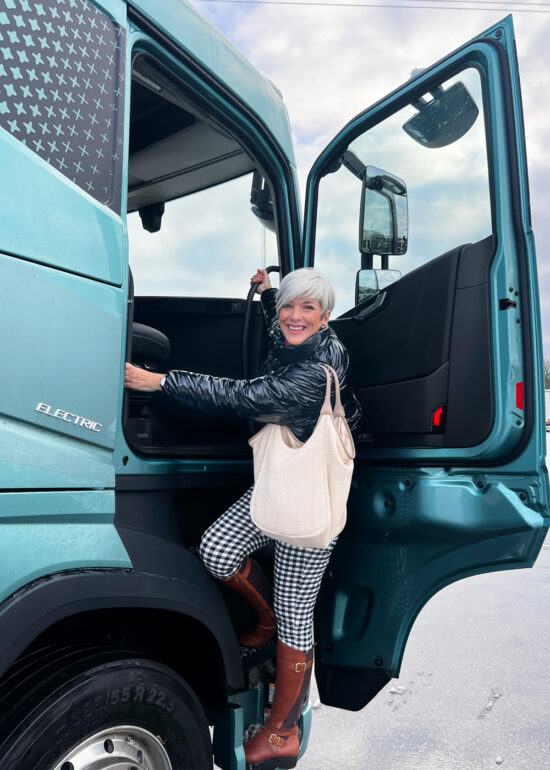Early movers embrace electric truck technologies
Early movers embrace electric truck technologies
Fresh from a trip to Sweden and a drive in the new Volvo FH Electric
6×4 TT, NICCI SCOTT-ANDERSON ponders e-mobility and its rollout in South Africa.
In February, I got the chance to test drive the new Volvo FH Electric 6×4 TT in snowy conditions on the Volvo track in Gothenburg, Sweden. The vehicle was pulling a 40-tonne trailer, which was difficult to tell from the ease and smoothness of the ride. I was amazed by the performance of the electric truck, and wondered what factors were hindering the adoption of this promising technology by South African operators. After all, this is the future of truck technology.
The newly formed naamsa Heavy Commercial Vehicles New Energy Vehicle (NEV) sub-committee has been established to address the factors that currently hinder the adoption of NEVs, including electric vehicles (EVs). The committee is only able to recommend and advise, it is not able to make any changes to legislation. That remains the domain of the Department of Transport and the Department of Trade, Industry, and Competition. The NEV sub-committee includes representatives from major truck manufacturers Daimler, Hino, Isuzu, Iveco, MAN, Scania, UD, and Volvo Trucks. The primary aim of the NEV sub-committee is to research, promote, and drive the adoption of NEV solutions for commercial vehicles on behalf of naamsa’s members. “The committee’s work is crucial to ushering in changes to legislation that will support the adoption of EVs and other energy technologies in South Africa,” says Eric Parry, sustainable solutions manager at Volvo Trucks SA.
However, despite the known challenges, KDG Logistics – a leading auto logistics provider – has made history by purchasing the first Volvo EV for its local operation in Durban. The first of KDG’s two vehicles (it has ordered a second truck too) arrived in early March.
Given the significant investment costs associated with electric trucks and the usage constraints, I was curious to know why KDG had taken such a bold step. CEO Shabir Mansoor and Abdool Kamdar, manager: decarbonisation and net zero, explain that they believed it was essential to align their plan to reduce carbon emissions with that of Toyota’s “Towards Net Zero” decarbonisation plan, because Toyota is a key client of theirs.
Kamdar says the executive team of KDG was concerned that long-haul freight trucks may emit as much as 1 000 kg of CO2 per day. When that is factored over a fleet, the CO2 emissions can be significant. “We had to be proactive and take a stand not only to achieve the targets of the South African government’s National Green Transport Strategy – which intends to reduce the national CO2 emissions of transport by 5% by 2050 – but also because we value being a good corporate citizen, which has chosen to embrace global best practice in the reduction of CO2 emissions,” he explains.
Kamdar’s first project involved running tyre trials on low rolling resistance tyres – and he proudly states that the company saw a 20% reduction in their CO2 emissions as a result. “This was a significant achievement for KDG,” he says.
Thereafter, in collaboration with Lohr Industry, KDG designed the world’s first hybrid diesel/electric car carrier trailer – a huge R&D leap for the company. “The most obvious progression from there was to explore alternative energy trucks,” says Kamdar.
In 2017, he began researching available options, namely: biofuels, compressed natural gas and liquefied natural gas (CNG/LNG), hydrogen fuel cell and hybrid diesel/electric vehicles, and battery electric trucks. Biofuels would be great, but availability is the key challenge, while there are also concerns about engine life and vehicle warranty. The CNG/LNG fuel trucks, which are usually converted from diesel, typically lose eight to 12% of their total CNG/LNG to the atmosphere through “methane slip”. The environmental impact of CNG/LNG is about 30 times worse than CO2 when it comes to global warming, so this was ruled out as an option.
“We knew that we had to get our hands on an electric truck and start to get familiar with the technology and develop the supporting architecture. In 2018, I saw the electric truck prototype from Volvo. It was love at first sight,” enthuses Kamdar. “When Volvo announced the availability of two EVs for South Africa, we said YES!”
In a conversation with Parry, I learnt that the NEV sub-committee would address a number of factors impacting the adoption of new energy vehicles in South Africa, including requesting the increase of the overall lengths of tri-axles (from 18.5 to 20 m) and interlinks (from 22 to 23.5 m). Parry went on to explain that the current national trailer fleet is legislated around internal combustion engine (ICE) technology, and it would be easier to amend the legislation to suit the NEV solution, rather than to attempt to change the national trailer fleet in operation.
Furthermore, legislation should be adapted to support the specific NEV technology requirements, which currently limit the ability to operate within existing technical and legal frameworks. With the current technology, the weight penalty of a NEV vehicle compared to ICE technology is between one and two tonnes for both the truck tractor and freight carrier versions. A special weight dispensation needs to be legislated to support the new technology introduction.
The excitement at the arrival of the first two Volvo EVs in South Africa was tangible, but I still could not understand why it was so important to KDG to be the first mover, knowing that the cost of these trucks is three times that of a diesel truck, directly impacting their cost per kilometre (CPK). The vehicle will also have limited usage, until there are sufficient charging stations on all the major routes. When asked about KDG’s motivation, Mansoor explains: “Even though we know that each kilometre will cost us more, we just knew we had to do this. It is really important. Our KDG logo is green; we ARE green!”
While the NEV sub-committee sets to work, forward-thinking operators are aligning with OEMs to assess the performance of EVs in the local environment. For instance, Shoprite Checkers is running a pilot with Scania Trucks on a freight carrier, while Daimler has also identified an operator to pilot its new EV. Within the bus industry, Golden Arrow Bus Services (GABS) – located in the Western Cape – has been piloting two 37-seater electric buses. The company is now ready to meet the City of Cape Town’s objective to only acquire electric buses from 2025 onwards. This will see GABS rolling out sixty 65-seater electric buses within the next few years. In response to a LinkedIn post, I learnt that – while some multinationals had begun to roll out EVs in Europe – my followers believe the uptake in South Africa will be slow while the current economic climate prevails, along with the instability of the grid.
It is also essential that the South African government addresses the punitive import tariffs on electric trucks to encourage uptake. For instance, in Germany, there is an 80% tax rebate on electric trucks and the investment in charging equipment. These policies will certainly support operators and drive the adoption of EVs.
In conclusion, the adoption of electric trucks in South Africa may be hindered by various factors, including the cost of the vehicles, lack of supporting infrastructure, and outdated legislation. However, the establishment of the NEV sub-committee is a step in the right direction towards addressing these challenges. With the bold leadership of KDG Logistics and other local operators, we can begin to collect valuable data and move our country to a greener future.
Published by
Nicci Scott-Anderson
focusmagsa






